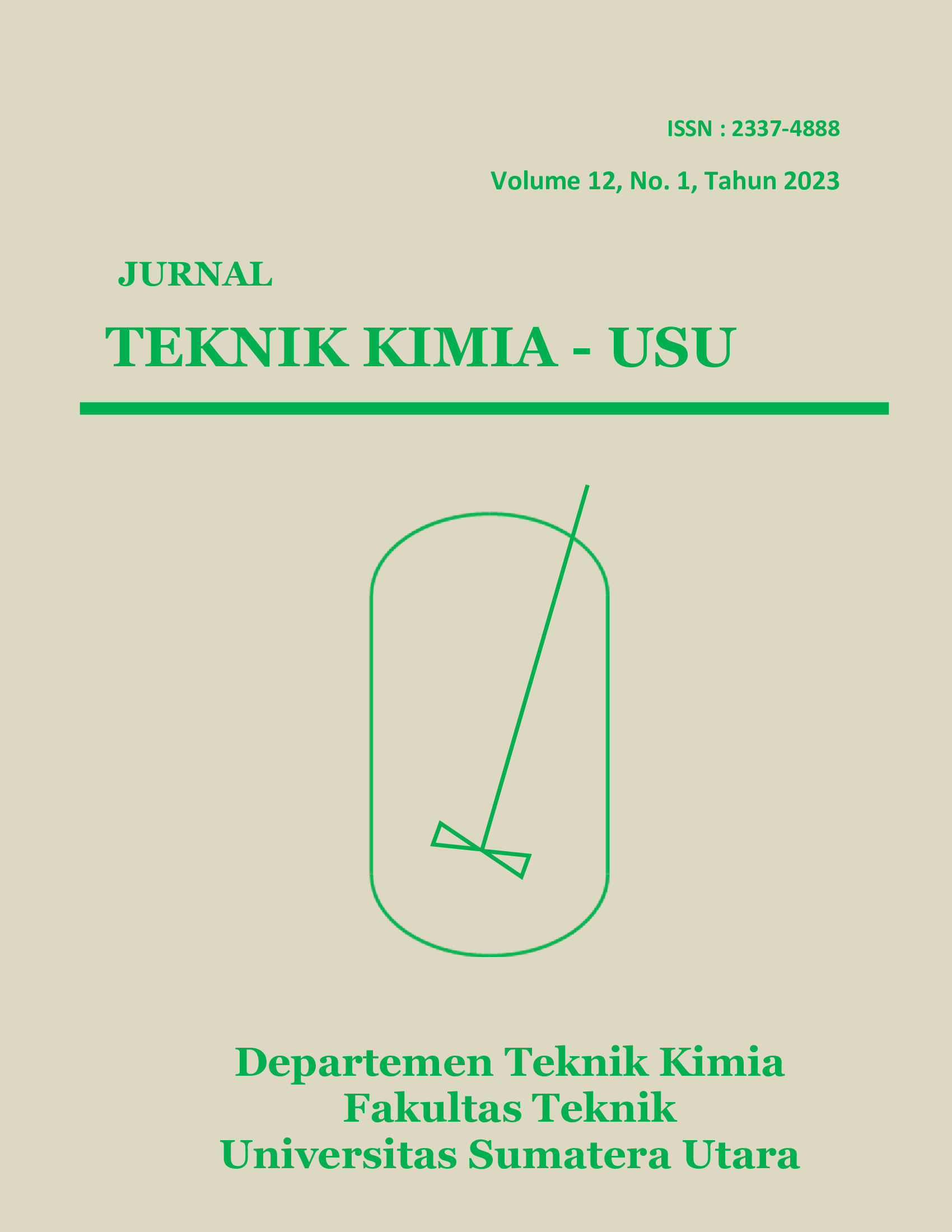Solidifikasi/Stabilisasi (S/S) Fly Ash yang Terkontaminasi Fenol sebagai Bahan Subtitusi dan Pengisi pada Pembuatan Beton
DOI:
https://doi.org/10.32734/jtk.v12i1.11185Keywords:
fly ash, phenol, solidification/stabilization, substitution, fillerAbstract
This study aims to assess the potential use of fly ash burning coal as a substitution and materials to making concrete filler. Material used in this study were fly ash waste product from PT. SOCI MAS, phenol, Portland cement type I, sand, gravel, and water.The use of fly ash as a substitution done with the variation in the percentage of 0%, 5 %, 10 %, 20 %, and 30 % of the weight of a cement used, and the use of fly ash as a filler material was carried out adding percentage variation of, 0%, 20 %, 40 %, 60 and 65 % of the weight of a cement used.The parameters for concrete are maximum load, compressive strength, water absorption, phenol analysis test amd loose weight metal after solidification/stabilization. The best result of using fly ash as a substitution acquired at 10 % substitution that produces a maximum load of 680 kN, strong press of 32840 MPa, and the water adsorption of 1.275 %, and as a filler best results obtained on the use of the 65 filler % that produces a maximum of 825 kN and strong press of 39.494, and the water adsorption of 0,123 % MPa. The results of the analysis free phenol and metal such as Zn, Cu, Ba are 0.003 ppm, 0.010 ppm, 0.022 ppm, 0.170 ppm.Â
Downloads
References
Anonim, Publikasi Statistik Pertambangan Non Minyak dan Gas Bumi, Jakarta: Badan Pusat Statistik, 2020.
D. R. W. Syaka, “Pembuatan beton normal dengan fly ash menggunakan mix desain yang dimodifikasi,†Skripsi, Universitas Jember, Jember, 2013.
A. Zakaria, H. Rochaeni, W. Djasmasari, Y. Purawamargapratala, and A. Taufiq, “Karakterisasi dan pemanfaatan abu terbang aktivasi fisika dalam menjerap ion logam Cu2+,†in Prosiding Pertemuan Ilmiah Ilmu Pengetahuan dan Teknologi Bahan, 2012, pp. 160–167.
J. H. Nasution and Iriany, “Pembuatan adsorben dari cangkang kerang bulu yang diaktivasi secara termal sebagai pengadsorpsi fenol,†Jurnal Teknik Kimia USU, vol. 4, no. 4, pp. 51–57, 2015.
K. Jitchaiyaphum, T. Sinsiri, and P. Chindaprasirt, “Cellular lightweight concrete containing pozzolan materials,†in Procedia Engineering, 2011, vol. 14, pp. 1157–1164.
Anonim, Peraturan Pemerintah (PP) Tentang Pengelolaan Limbah Bahan Berbahaya Dan Beracun, Jakarta: Peraturan Pemerintah Republik Indonesia, 2014.
A. Harison, V. Srivastava, and A. Herbert, “Effect of fly ash on compressive strength of portland pozzolona cement concrete,†Journal of Academia and Industrial Research, vol. 2, no. 8, pp. 476–479, 2014.
Q. Tang, Y. Liu, F. Gu, and T. Zhou, “Solidification/stabilization of fly ash from a municipal solid waste incineration facility using portland cement,†Advances in Materials Science and Engineering, pp. 1–10, 2016.
J. Lubis, “Kajian eksperimental pemanfaatan limbah abu terbang (fly ash) PLTU Labuhan Angin Sibolga sebagai campuran beton,†Skripsi, Universitas Sumatera Utara, Medan, 2016.
R. Mall, S. Shrama, and R. D. Patel, “Studies of the properties of paver block using fly ash,†IJSRD-International Journal for Scientific Research & Development, vol. 2, no. 10, pp. 59–64, 2014.
Usman, “Potensi limbah abu terbang (fly ash) batubara sebagai bahan substitusi dan bahan pengisi (filler) pada pembuatan beton,â€Skripsi, Universitas Sumatera Utara, Medan, 2018.
D. Dermawan and M. L. Ashari, “Studi komparasi kelayakan teknis dan lingkungan pemanfaatan limbah B3 sandblasting dan fly ash sebagai campuran beton,†Jurnal Presipitasi: Media Komunikasi dan Pengembangan Teknik Lingkungan, vol. 15, no. 1, pp. 25–30, 2018.
W. Kushartomo and N. Hendrawan, “Pengaruh perpaduan copper slag dan abu terbang terhadap sifat mekanis reactive powder concrete,†in Seminar Nasional Teknologi dan Sains (SNTS) II, 2016, pp. 1–8.
M. Munir, “Pemanfaatan abu batubara (fly ash) untuk hollow block yang bermutu dan aman bagi lingkungan,†Tesis, Universitas Diponegoro, Semarang, 2008.
A. B. Saputro, “Kuat tekan dan kuat tarik beton mutu tinggi dengan fly ash sebagai bahan pengganti sebagian semen,†RADIAL - Jurnal Peradaban Sains, Rekayasa Dan Teknologi, vol. 8, no. 1 pp. 25-33, 2008.
I. M. A. K. Salain, “Penggunaan akselerator pada beton yang menggunakan perekat berupa campuran semen portland tipe I dan abu terbang,†in Prosiding Seminar Nasional Teknik Sipil 1 (SeNaTS 1), 2015, pp. 113–118.
Pedoman Konstruksi dan Bangunan, “Pedoman Pelaksanaan Pekerjaan Beton untuk Jalan dan Jembatan Pd T-07-2005-B,†Jakarta: Departemen Pekerjaan Umum, 2005.
D. Sitindaon and M. H. Harahap, “Pengaruh penambahan styrofoam pada pembuatan beton ringan menggunakan pasir merah labuhan batu selatan,†Jurnal Einstein, vol. 2, no. 3, pp. 14–19, 2014.
A. R. J. Nabal, L. R. Cahyaningsih, and H. K. P. Pandong, “Pengaruh penambahan fly ash terhadap kuat tekan beton mutu tinggi,†Lomba Kuat Tekan Beton Mutu Tinggi, Universitas Atma Jaya Yogyakarta, Yogyakarta, 2014.
K. K. B. Siram, “Cellular light-weight concrete blocks as a replacement of burnt clay bricks,†International Journal of Engineering and Advanced Technology (IJEAT), vol. 2, no. 2, pp. 149–151, 2012.
Anonim, Persyaratan Teknis Pengolahan Limbah Bahan Berbahaya dan Beracun. Jakarta: Keputusan Kepala Badan Pengendalian Dampak Lingkungan, 1995.
S. L. Patil, J. N. Kale, and S. Suman, “Fly Ash Concrete: A technical analysis for compressive strength,†International Journal of Advanced Engineering Research and Studies, vol. 2, no. 1, pp. 128–129, 2012.
Downloads
Published
Issue
Section
License
Copyright (c) 2023 Jurnal Teknik Kimia USU

This work is licensed under a Creative Commons Attribution-ShareAlike 4.0 International License.

















